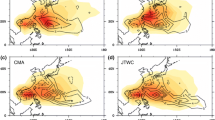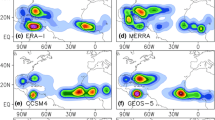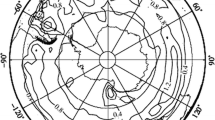Abstract
An objective cyclone tracking algorithm is applied to twentieth century reanalysis (20CR) 6-hourly mean sea level pressure fields for the period 1871–2010 to infer historical trends and variability in extra-tropical cyclone activity. The tracking algorithm is applied both to the ensemble-mean analyses and to each of the 56 ensemble members individually. The ensemble-mean analyses are found to be unsuitable for accurately determining cyclone statistics. However, pooled cyclone statistics obtained by averaging statistics from individual members generally agree well with statistics from the NCEP-NCAR reanalyses for 1951–2010, although 20CR shows somewhat weaker cyclone activity over land and stronger activity over oceans. Both reanalyses show similar cyclone trend patterns in the northern hemisphere (NH) over 1951–2010. Homogenized pooled cyclone statistics are analyzed for trends and variability. Conclusions account for identified inhomogeneities, which occurred before 1949 in the NH and between 1951 and 1985 in the southern hemisphere (SH). Cyclone activity is estimated to have increased slightly over the period 1871–2010 in the NH. More substantial increases are seen in the SH. Notable regional and seasonal variations in trends are evident, as is profound decadal or longer scale variability. For example, the NH increases occur mainly in the mid-latitude Pacific and high-latitude Atlantic regions. For the North Atlantic-European region and southeast Australia, the 20CR cyclone trends are in agreement with trends in geostrophic wind extremes derived from in-situ surface pressure observations. European trends are also consistent with trends in the mean duration of wet spells derived from rain gauge data in Europe.















Similar content being viewed by others
References
Alexander LV, Wang XLL, Wan H, Trewin B (2011) Significant decline in storminess over southeast Australia since the late 19th century. Aust Meteorol Oceanogr J 61:23–30
Alexandersson H, Schmith T, Iden K, Tuomenvirta H (1998) Long-term variations of the storm climate over NW Europe. Global Atmos Ocean Syst 6:97–120
Armstrong RL, Brodzik MJ (1995) An earth-gridded SSM/I data set for cryospheric studies and global change monitoring. Adv Space Res 16(10):155–163
Berry G, Jakob C, Reeder M (2011) Recent global trends in atmospheric fronts. Geophys Res Lett 38:L21812. doi:10.1029/2011GL049481
Compo GP, Whitaker JS, Sardeshmukh PD, Matsui N, Allan RJ, Yin X, Gleason BE Jr, Vose RS, Rutledge G, Bessemoulin P, Brönnimann S, Brunet M, Crouthamel RI, Grant AN, Groisman PY, Jones PD, Kruk MC, Kruger AC, Marshall GJ, Maugeri M, Mok HY, Nordli Ã, Ross TF, Trigo RM, Wang XLL, Woodruff SD, Worley SJ (2011) The twentieth century reanalysis project. Q J R Meteorol Soc 137:1–28. doi:10.1002/qj.776
Dee DP, Uppala S (2009) Variational bias correction of satellite radiance data in the ERA-Interim reanalysis. Q J R Meteorol Soc 135:1830–1841
Geng Q, Sugi M (2001) Variability of the North Atlantic cyclone activity in winter analyzed from NCEP-NCAR reanalysis data. J Clim 14:3863–3873
Gulev SK, Zolina O, Grigoriev S (2001) Extratropical cyclone variability in the Northern Hemisphere winter from the NCEP/NCAR reanalysis data. Clim Dyn 17:795–809
Hanson CE, Palutikof JP, Davies TD (2004) Objective cyclone climatologies of the North Atlantic? A comparison between ECMWF and NCEP reanalyses. Clim Dyn 22:757–769
Hodges KI, Lee RW, Bengtsson L (2011) A comparison of extra-tropical cyclones in recent RE-analyses; ERA-INTERIUM, NASA-MERRA, NCEP-CFSR and JRA25. J Clim 24:4888–4906. doi:10.1175/2011JCLI4097.1
Hodges KI, Hoskins BJ, Boyle J, Thorncroft C (2003) A comparison of recent reanalysis datasets using objective feature tracking: storm tracks and tropical easterly waves. Mon Wea Rev 131:2012–2037
Hoskins BJ, Hodges KI (2002) New perspectives on the northern hemisphere winter storm tracks. J Atmos Sci 59:1041–1061
Kalnay E, Kanamitsu M, Kistler R, Collins W, Deaven D, Gandin L, Iredell M, Saha S, White G, Woollen J, Zhu Y, Chelliah M, Ebisuzaki W, Higgins W, Janowiak J, Mo KC, Ropelewski C, Wang J, Leetmaa A, Reynolds R, Jenne R, Joseph D (1996) The NCEP/NCAR 40-year reanalysis project. Bull Am Meteor Soc 77:437–471
Kistler R et al (2001) The NCEP-NCAR 50-year reanalysis: monthly means CD-Rom and documentation. Bull Am Meteor Soc 82:247–267
Onogi K et al (2007) The JRA-25 reanalysis. J Meteor Soc Japan 85:369–432
Raible CC, Della-Marta P, Schwierz C, Wernli H, Blender R (2007) Northern Hemisphere midlatitude cyclones: a comparison of detection and tracking methods and different re-analyses. Mon Wea Rev 136:880–897. doi:10.1175/2007MWR2143.1
Rienecker MM et al. (2009) The GEOS-5 data assimilation system-documentation of versions 5.0.1, 5.1.0, and 5.2.0. Technical Report Series on Global Modeling and Data Assimilation, NASA/TM-2007-104606, M.J. Suarez, 731 Ed., vol. 27, 95 pp
Rienecker MM, coauthors (2010) The NASA modern era retrospective-analysis for research and applications (MERRA). J Clim (in preparation)
Rayner NA, Parker DE, Horton EB, Folland CK, Alexander LV, Rowell DP, Kent EC, Kaplan A (2003) Global analyses of sea surface temperature, sea ice, and night marine air temperature since the late nineteenth century. J Geophys Res 108(D14):4407. doi:10.1029/2002JD002670
Saha S et al (2010) The NCEP climate forecast system reanalysis. Bull Am Meteor Soc 91:1015–1057. doi:10.1175/2010BAMS3001.1
Serreze MC (1995) Climatological aspects of cyclone development and decay in the Arctic. Atmos Ocean 33:1–23
Serreze MC, Carse F, Barry RG, Rogers JC (1997) Icelandic low cyclone activity: climatological features, linkages with the NAO, and relationships with recent changes in the northern hemisphere circulation. J Clim 10(3):453–464
Simmonds I, Keay K (2000) Variability of southern hemisphere extratropical cyclone behavior, 1958-97. J Clim 13:550–561
Ulbrich U, Leckebusch GC, Pinto JG (2009) Extra-tropical cyclones in the present and future climate: a review. Theor Appl Climatol 96:117–131. doi:10.1007/s00704-008-0083-8
Wang XLL (2008) Accounting for autocorrelation in detecting mean shifts in climate data series using the penalized maximal t or F test. J Appl Meteor Climatol 47:2423–2444. doi:10.1175/2008JAMC1741.1
Wang XLL (2008) Penalized maximal F test for detecting undocumented mean shift without trend change. J Atmos Oceanic Technol 25:368–384. doi:10.1175/2007/JTECHA982.1
Wang XLL (2003) Comments on “detection of undocumented changepoints: a revision of the two-phase regression model”. J Clim 16:3383–3385
Wang XLL, Feng Y (2010) RHtestsV3 user manual. Available online at http://cccma.seos.uvic.ca/ETCCDMI/RHtest/RHtestsV3_UserManual.doc.Climate Research Division, Science and Technology Branch, Environment Canada, Toronto, Ontario, Canada, 26 pp (published online 2010)
Wang XLL, Swail VR, Zwiers FW (2006) Climatology and changes of extra-tropical cyclone activity: comparison of ERA-40 with NCEP/NCAR Reanalysis for 1958–2001. J Clim 19:3145–3166. doi:10.1175/JCLI3781.1
Wang XLL, Wan H, Zwiers FW, Swail VR, Compo GP, Allan RJ, Vose RS, Jourdain S, Yin X (2011) Trends and low-frequency variability of storminess over western Europe, 1878–2007. Clim Dyn 37:2355–2371. doi:10.1007/s00382-011-1107-0
Wang XLL, Wen QH, Wu Y (2007) Penalized maximal t test for detecting undocumented mean change in climate data series. J Appl Meteor Climatol 46(No. 6):916–931. doi:10.1175/JAM2504.1
Wang XLL, Zwiers FW, Swail VR, Feng Y (2009) Trends and variability of storminess in the northeast atlantic region, 1874–2007. Clim Dyn 33:1179–1195. doi:10.1007/s00382-008-0504-5
Wen QH, Wang XLL, Wong A (2011) A hybrid-domain approach to modeling climate data time series. J Geophys Res 116:D18112. doi:10.1029/2011JD015850
Wernli H, Schwierz C (2006) Surface cyclones in the ERA-40 data set (1958–2001). Part I: novel identification method and global climatology. J Atmos Sci 63: 2486-2507
Whitaker JS, Hamill TM (2002) Ensemble data assimilation without perturbed observations. Mon Wea Rev 130:1913–1924
Zolina O, Simmer C, Gulev SK, Koller S (2010) Changing structure of Europe precipitation: longer wet periods leading to more abundant rainfalls. Geophys Res Lett 37:L06704. doi:10.1029/2010GL042468
Acknowledgments
The authors wish to thank Mr. Rodney Chan for his help in manipulating the large dataset and running the cyclone tracking algorithm. The authors are grateful to Dr. Mark Serreze (University of Colorado) for providing us his cyclone tracking codes, and to Dr. John Fyfe for his helpful internal review of an earlier version of this manuscript. The authors wish to thank the two anonymous reviewers for their constructive review comments. The Twentieth Century Reanalysis Project used resources of the National Energy Research Scientific Computing Center and of the Oak Ridge Leadership Computing Facility at Oak Ridge National Laboratory, which are supported by the Office of Science of the US Department of Energy under Contract No. DE-AC02-05CH11231 and Contract No. DE-AC05-00OR22725, respectively. Support for the Twentieth Century Reanalysis Project dataset is provided by the US Department of Energy, Office of Science Innovative and Novel Computational Impact on Theory and Experiment (DOE INCITE) program, and Office of Biological and Environmental Research (BER), and by the National Oceanic and Atmospheric Administration Climate Program Office.
Author information
Authors and Affiliations
Corresponding author
Electronic supplementary material
Below is the link to the electronic supplementary material.
Rights and permissions
About this article
Cite this article
Wang, X.L., Feng, Y., Compo, G.P. et al. Trends and low frequency variability of extra-tropical cyclone activity in the ensemble of twentieth century reanalysis. Clim Dyn 40, 2775–2800 (2013). https://doi.org/10.1007/s00382-012-1450-9
Received:
Accepted:
Published:
Issue Date:
DOI: https://doi.org/10.1007/s00382-012-1450-9




